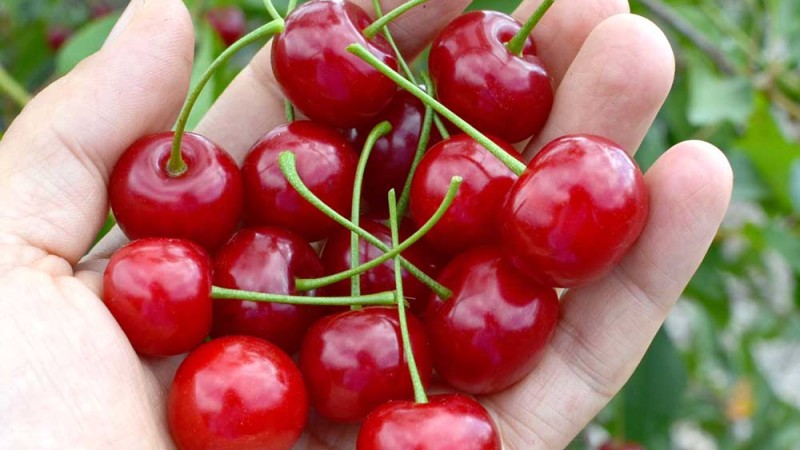
Šľachtenie trpasličích višní vhodných na komerčnú produkciu v drsných podmienkach kanadských prérií sa začal v 40. rokoch 20. storočia. Dlhodobé šľachtiteľské úsilie spojilo vysokú odolnosť voči mrazu, trpasličí vzrast a dobrú kvalitu plodov do konečného produktu. Výsledkom šľachtenia na Univerzite v Saskatchewane sú višne s vynikajúcou chuťou a vysokým obsahom cukru. Majú tiež veľmi dobrý potenciál pre mechanický zber, ktorý je nevyhnutný pre komerčnú produkciu ovocia.
Dr. Les Kerr, vedúci Centra lesného hospodárstva Shelterbelt, strávil 40 rokov súkromným šľachtením višní s cieľom vyvinúť odolnú odrodu pre prérie. Počas svojej intenzívnej práce sa venoval kríženiu Európskych odrôd višne Prunus cerasus a Mongolskej višne Prunus fruticosa. Snažil sa skombinovať extrémnu mrazuvzdornosť a trpasličí vzrast Mongolskej višne s kvalitou plodov Európskej višne.
Jeho práca nezostala zabudnutá. Pokračovali v nej Dr. Nelson, Rick Sawatzky a neskôr Dr. Robert Bors, pracujúci v Programe vedeckého výskumu a šľachtenia višní na Univerzite v Saskatchewane. V 80-tych rokoch 20. storočia daroval Dr. Kerr celý genofond višní Univerzite. O niekoľko rokov neskôr sa začala ďalšia fáza šľachtenia, keď sa uskutočnili kríženia medzi mrazuvzdornými výbermi Mongolskej višne s veľkými plodmi a najlepšími Európskymi kultivarmi višní. Výsledkom boli hybridy s 75%-ným podielom genómu Prunus cerasus a 25%-ným Prunus fruticosa.
Tieto hybridy mali vyvážené vlastnosti oboch svojich rodičov. Získali extrémnu mrazuvzdornosť, dobrú kvalitu plodov, len veľkosť plodov bola oproti najlepším odrodám višní polovičná. Spoločným znakom týchto hybridov bolo, že mali geneticky vrodený nízky kríkový vzrast. V dospelosti dosahovali výšku len 2 – 2,5 m. Bola to výhoda, nebolo potrebné štepenie na slabo rastúce podpníky, mohli sa pestovať ako pravokorenné.
To bol prísľub do budúcnosti, pretože trpasličie višne sa dali jednoducho vegetatívne množiť drevnatými odrezkami alebo in-vitro. A to vo veľkých sériách a s nízkymi nákladmi. Trpasličie višne boli v Saskatchewane od začiatku šľachtené na komerčnú produkciu a spracovanie v potravinárskom priemysle. Kríkoý tvar predurčuje takéto rastliny na výsadbu v rade, podobne ako muchovníky, arónie alebo maliny, s takou šírkou medziradia ktorá umožní prejazd zberacieho kombajnu.
V roku 1999 vznikol prvý kultivar trpasličej višne zo Saskatchewanu, CARMINE JEWEL.V súčasnosti je odroda Carmine Jewel doplnená o ďalšie nové odrody trpasličích višní, ktoré sa veľkosťou plodov približujú k európskym višniam. Charakter vzrastu ich predurčuje na pestovanie v malých záhradách, hoci tento účel šľachtitelia sprvu nemali na mysli. Plody majú tmavočervenú, pri dozretí príjemnú sladkú šťavu, ktorá sa u višni neočakáva.
V roku 2004 bola predstavená séria trpasličích višní ROMANCE. Táto séria zahŕňa odrody Juliet, Romeo, Cupid, Valentine a Crimson Passion. V nasledujúcich rokoch boli vyšľachtené odrody BIG RED, SWEET THING a CUTIE PIE.
Séria MUSKETEER bola vyšľachtená v rokoch 2021-2022 na počesť osláv 100. výročia záhradníctva na Univerzite v Saskatchewane. Zahŕňa odrody d'Artagnon, Athos, Porthos a Aramis.
Obchodný potenciál
Dominantným produktom ktorý dodávajú na trh pestovatelia čerešní v štáte Michigan je plnka do tradičného čerešňového koláča. Problémom súčasných čerešní je ale nedostatok farbiva v dužine. Počas spracovania nastáva rýchla oxidácia a farba sa mení na hnedú. Aby sa tomu zabránilo, počas spracovania sa musia použiť prostriedky ktoré rýchlej oxidácii zabránia, alebo ju aspoň spomalia. Nuž a nakoniec je potrebné aj tak dodať umelé farbivo, aby mala plnka do čerešňového koláča lákavú sviežu farbu ktorá sa dobre predáva. Tmavo-purpurová farba dužiny trpasličích višní je neopakovateľná. Saskatchewanské višne sa uplatnia nielen ako excelentná surovina na výrobu plnky do čerešňového koláča. Rovnako aj zdraviu prospešné produkty ako višňová šťava, višňové víno, sušené višne alebo višňové muffiny sú zaujímavým obohatením trhu.










